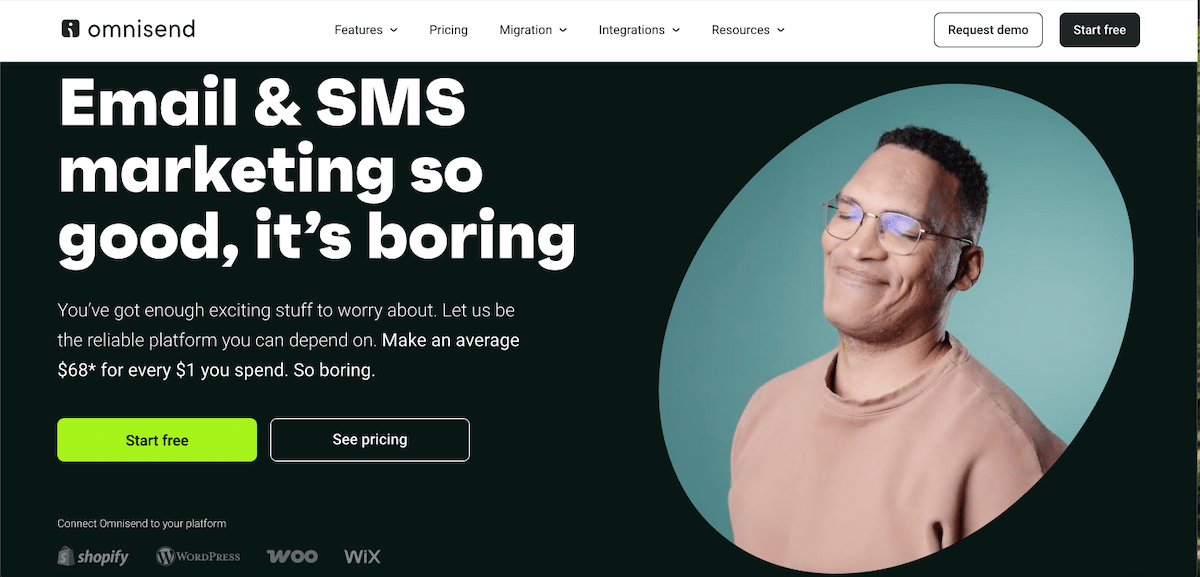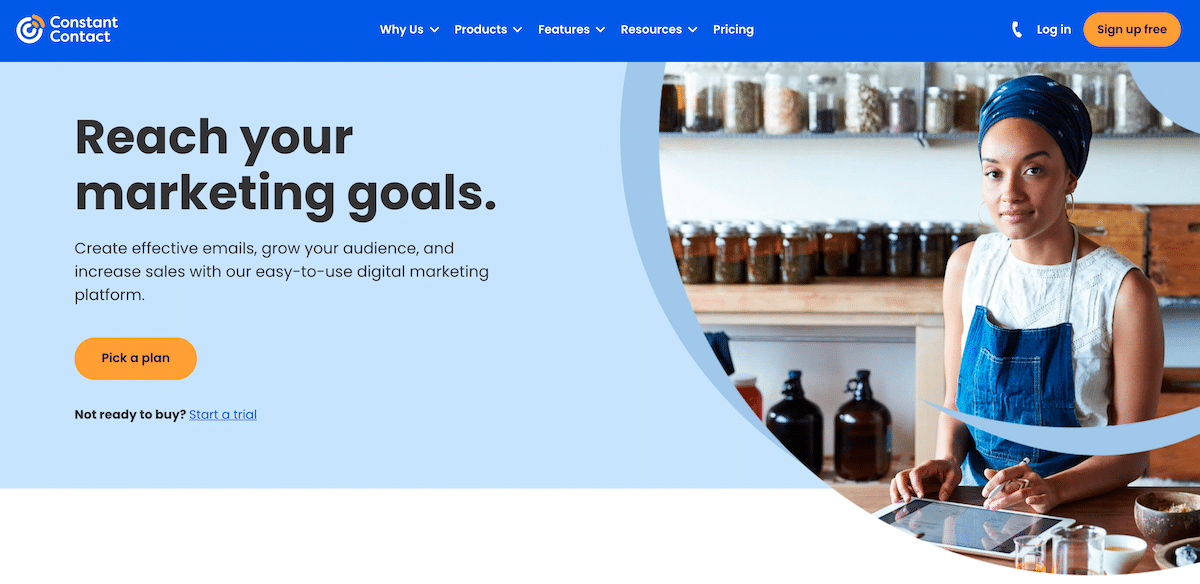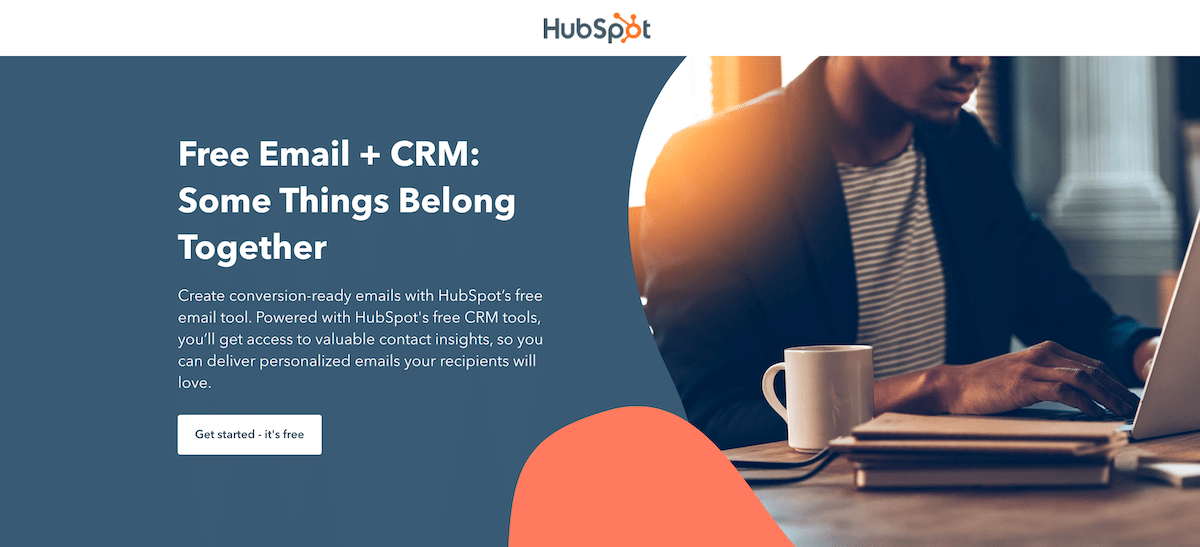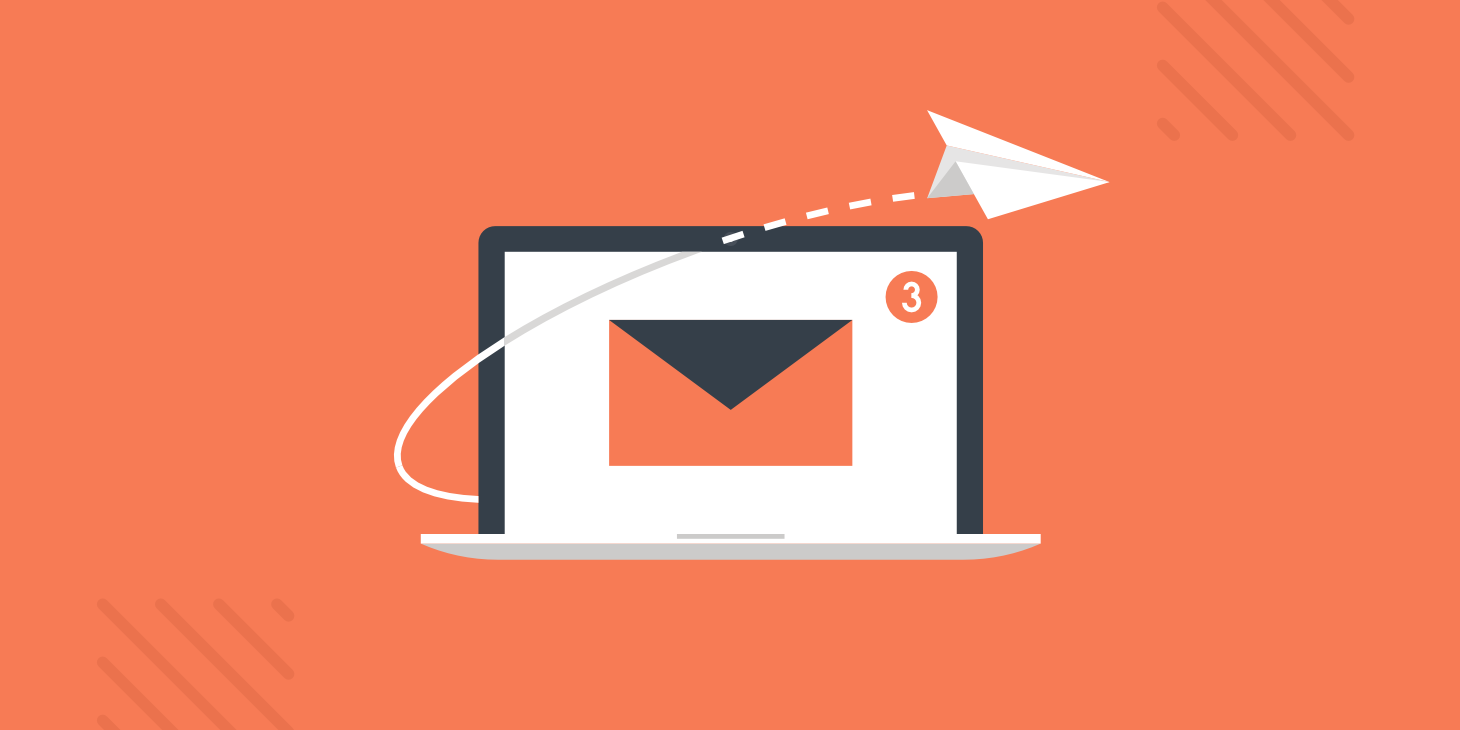Email is one of the most powerful tools your business has for building and retaining a customer base.
For one thing, your audience likes it. 51% of consumers say email is the way they prefer to be contacted by brands. That makes it more popular than any other channel.
Email also has a great return on investment (ROI). Every $1 invested in email marketing earns an average of $35.
But creating and sending emails regularly gets time-consuming, especially as your business grows.
To get the most out of your email marketing, you need to automate it.
Luckily, some tools make this easy to do. This article will introduce email marketing automation, including how to do it and what platforms are best for the job.
What Is Email Marketing Automation?
Email marketing automation uses automated workflows to send the right email to the right person at the right time.
At its most basic, email marketing automation could mean scheduling an email to send at a specific time. But email automation can do much more than that.
An email or an entire series of emails can be sent based on a variety of triggers. For example, you can send an email based on an action a user takes on your website.
Modern email marketing automation software takes a lot of manual work off your hands by simplifying:
- Subscriber list management
- Email creation
- Message personalization
- A/B testing
- Analytics
Benefits of Email Marketing Automation
We’ve already discussed the high ROI of email marketing and that consumers prefer to be contacted by email.
But why do you need to use an email marketing automation tool?
Here are a few reasons.
Efficiency
Email automation saves you time and effort. For example, you don’t have to compile and manage your subscriber list manually.
Or, let’s say you want to send an email to many people, but you want them to get it at different times based on their time zone or work schedule.
It would be unreasonable to send emails throughout the day manually. But an email marketing platform tool can do it automatically while you work on other tasks.
Many automation platforms can even figure out the optimal time to send the email to each list member.
Scalability
If you just have a few subscribers on your list, you can send them your latest updates without an automation solution. But sending regular emails (including news, promotions, helpful content, and more) to multiple segments of an extensive list becomes impossible.
An email marketing automation platform can grow your business. You can send regular, targeted emails to everyone on your list, no matter how big it gets.
Improved Customer Retention Rate
Customers tend to have a short attention span.
They might have bought your product once, but if they never hear from you again, they’ll forget about you. Who can blame them? They see marketing emails, ads, and social media posts from other companies every day.
Without automated emails, it’s challenging to maintain a relationship with your customers.
Email marketing automation can keep your existing customers engaged and remind them that they like your product.

Message Personalization
One-size-fits-all emails just don’t cut it anymore.
72% of consumers say they only engage with marketing messages tailored to their interests. For the “frequent shoppers,” it’s even more accurate. 80% of them will only buy from brands that personalize the experience.
Marketers understand this — 69% are using some type of email personalization.
To be competitive, you have to personalize your email messaging too. An email marketing automation platform can help you do that without adding a lot of extra manual work.
When to Use Email Marketing Automation
Automated emails are highly customizable to the needs of your business. You can send any type of email at any time.
That said, there are a few key types of marketing emails we recommend businesses include in their email marketing strategies.
Abandoned Cart Emails
Almost 70% of shopping carts are abandoned on ecommerce websites.
You can get some of these people to come back and complete their purchases. Send an email reminding them about the item in their cart. Making the customer a special offer on that item might entice them back.
You can achieve this by integrating your email automation tool with website tracking. It’s even possible to send emails based on other site visitor behavior, like looking at a resource on a particular subject.
Newsletters
Sending newsletters on a regular schedule is an effective way to keep your audience engaged.
They let you put various important information into one email — like company news, events, promotions, and exciting content.
Promotional Emails
Promotional emails are email campaigns designed to get the word out about something your business is offering. They could be centered around a product launch, a service, free downloadable content, or an upcoming event.
They often give your subscribers discounts or special deals on the product.
Promotional emails can be very successful at getting people interested in your brand. They work best when you target subscribers most likely to be interested in the promotion.
New Subscriber Welcome Emails
Businesses spend a lot of time nurturing existing contacts, but do you know when a list subscriber is most likely to buy from you?
Right after they subscribe.
At that moment, they have enough interest in your business to join your mailing list. It’s an excellent opportunity to nudge them toward converting.
Do this by sending a welcome email or even a series of welcome emails. Welcome emails are well received — they have an average open rate of 86.03%.
Compare that to the average open rate of a newsletter at 18.76%

Event and Appointment Reminders
Have an upcoming event?
Don’t let your audience forget about it. Scheduling a few event reminder emails can increase attendance. You can also automate reminders for individual appointments.
Auto-Replies to Inquiries
When potential customers contact you, they appreciate a prompt reply. But you’re probably not available to send an immediate response to every email.
With email marketing automation, you can set up an auto-reply to inquiries. For example, you might let the person know how soon they can expect a response from a human and direct them toward relevant resources in the meantime.
Key Features of Email Marketing Automation Tools
Hopefully, you feel convinced of the benefits of an email marketing automation solution. So let’s look at what email software can do.
Email Campaign Building Tools
Before you can worry about automated triggers and A/B testing, you have to create an email.
It should look professional and include your branding. These days, it’s crucial that it’s also mobile responsive.
Luckily, you don’t need design or coding resources to make this happen. The top email marketing tools provide templates that you can edit to build a sleek, responsive email.
Triggers
A trigger is what causes an automated email campaign to send.
You could use a time trigger — for example, at 5 p.m. on Jan. 20.
There are also more advanced triggers. An email can be automatically sent when someone:
- Subscribes to your list
- Takes a particular action on your website
- Clicks a link in your previous email campaign
- Has a birthday or reaches an anniversary with your company
- Purchases your product
Unlike promotional emails or newsletters, these types of emails are sent to individual list subscribers at just the right time.
Automated Drip Campaigns
A drip campaign is a series of related emails. They’re often used to nurture leads through the customer journey.
Drip emails can be on a simple schedule. For example, a subscriber joining your list could trigger informational emails about your product to be sent to them once per month.
Some drip campaigns have a more complex flow. For example, the second email in the series could be different for subscribers who opened the first email and those who didn’t.

A/B Testing
A/B testing, also called split testing, helps you improve your campaign performance. An A/B test is when you send multiple versions of an email — usually to a small test group — to see which one performs better.
For example, it’s common to test sending the same email with different subject lines. Depending on your email marketing platform, you might have other options, like testing content or images. There are several different types of A/B testing tools available.
An A/B test not only helps you select the best version of your email but also lets you learn more about your audience.
Response Tracking and Analytics
Email marketing isn’t just about sending emails. It’s about engagement.
You need to be able to see the response to your emails. Are they being opened? How many people clicked each link?
Email marketing automation platforms usually provide reporting and analytics to help you measure the success of your emails and improve future campaigns.
Top Email Marketing Automation Tools
There are tons of email marketing tools on the market. These are a few of the best.
1. Mailchimp
Mailchimp is the dominant player in the email marketing world with a 72.97% market share. There’s a reason so many companies use it.
Mailchimp makes it easy to create professional-looking, branded emails, and its testing and analytics are top-notch. Even better, it’s a cost-effective solution for businesses of all sizes.
If you have fewer than 2,000 contacts and send fewer than 10,000 emails per month, you can use Mailchimp for free.
The price of the paid plans is based on how many contacts you have, so a business with 500 contacts won’t pay as much for premium features as a business with 50,000 contacts will.

Key Features
- Email builder with templates
- Segmentation and list management
- Personalization
- Advanced automation
- Reporting and analytics
- Landing pages
- A/B and multivariate testing
- Send time optimization
Pricing
- Free: Limit of 2,000 contacts
- Essentials: Starts at $9.99/month for 500 contacts
- Standard: Starts at $14.99/month for 500 contacts
- Premium: Starts at $299/month for 10,000 contacts
2. Omnisend
Omnisend is a robust email and SMS marketing automation platform tailored for e-commerce businesses aiming to enhance customer engagement and drive sales. It offers a suite of features designed to streamline marketing efforts across multiple channels.

Omnisend’s intuitive interface and powerful features make it a suitable choice for e-commerce businesses seeking to automate their marketing efforts and enhance customer relationships.
Key Features
- Drag-and-drop email builder
- Advanced segmentation
- Pre-built automation workflows
- Multichannel messaging
- Personalization
- A/B testing
- Real-time reporting
Pricing
- Free Plan: Allows up to 250 contacts and 500 emails per month, providing access to all standard features.
- Standard Plan: Starting at $16/month for 500 contacts, includes 6,000 emails/month and unlimited web push notifications.
- Pro Plan: Starting at $59/month for 2,500 contacts, offers unlimited emails and push notifications, along with monthly SMS credits equivalent to the plan’s price.
3. Constant Contact
Constant Contact is the second most popular email marketing automation platform, although it only has a 5.36% market share.
Constant Contact has many of the same features as Mailchimp, like templates, automation, and analytics.
It also has some unique features to help nonprofits fundraise.

However, Constant Contact doesn’t have a free version, and the paid plans are more expensive than Mailchimp’s.
Key Features
- Email builder with templates
- Segmentation and list management
- Personalization
- Advanced automation
- Reporting and analytics
- A/B testing
- Landing pages
- Fundraising tools
Pricing
- Email: Starts at $20/month for 500 contacts
- Email Plus: Starts at $45/month for 500 contacts
- Ecommerce Pro: Starts at $195/month for 2,500 contacts
4. HubSpot
HubSpot is best known as a CRM platform or a suite of marketing tools. Its Marketing Hub includes email. Hubspot email is worth considering if you also want to use Hubspot’s other marketing solutions.

It has a free plan that lets you send up to 2,000 emails per month. After that, you can purchase a paid Marketing Hub plan.
Key Features
- Email builder with templates
- Segmentation and list management
- Personalization
- Advanced automation
- Reporting and analytics
- A/B testing
- Integration with CRM and other marketing tools
Pricing
- Free Hubspot Email: Limit of 2,000 emails per month
- Marketing Hub Starter: Starts at $45/month for 1,000 marketing contacts
- Marketing Hub Professional: Starts at $800/month for 2,000 marketing contacts
- Marketing Hub Enterprise: Starts at $3,200/month for 10,000 marketing contacts
5. AWeber
AWeber has 600+ email templates and easy-to-use automation options.
Its pricing is based on how many contacts you have. Whether you have 50 subscribers on your list or 50,000, you get access to all of AWeber’s features.

This makes AWeber an excellent option for small businesses that want advanced capabilities without paying for an enterprise-level plan.
Key Features
- Email builder with templates
- Segmentation and list management
- Personalization
- Advanced automation
- Reporting and analytics
- A/B testing
- CMS integration
Pricing
- Ranges from free (0–500 subscribers) to $146.15/month (10,001–25,000 subscribers)
6. Sendinblue
Sendinblue is an affordable email marketing solution that’s competitive with more well-known platforms like Mailchimp.
In fact, in EmailToolTester’s last email deliverability test, Sendinblue’s 96.3% deliverability was better than Mailchimp, Constant Contact, AWeber, and Hubspot.
Sendinblue’s paid plans limit how many emails you can send, but not the size of your list. So unlike with Mailchimp or AWeber, businesses with lots of contacts can stay on the free plan.

Key Features
- Email builder with templates
- Segmentation and list management
- Personalization
- Advanced automation
- Reporting and analytics
- A/B testing
- API/Webhooks
- Chat
Pricing
- Free: Limit of 300 emails per day
- Lite: Starts at$25/month for 10,000 monthly emails
- Premium: Starts at $65/month for 20,000 monthly emails
- Enterprise: Custom pricing
The ones above are some of our favorites, but there are quite a few more as well.
Email Marketing Automation Best Practices
Once you’ve chosen your email marketing automation platform, follow the tips below to get the most out of the tool and learn about best practices.
1. Build a High-Quality List
Don’t just build a massive list of contacts. Try focusing on the quality of those contacts.
High-quality list subscribers are people who have already expressed an interest in your business, your product, or your content.
Those are the people most likely to convert.
You can create a high-quality list by letting subscribers opt-in. Some ways you can do that include:
- Adding signup forms to your website
- Including an “Add me to your list” checkbox at the bottom of your forms
- Collecting emails from people who download an asset
- Having a place for people to sign up at trade shows and other events
Many email marketing automation platforms provide forms to add to your website, but they’re not your only options. If you have a WordPress site, try one of these lead generation plugins.
2. Segment Your Audience
Businesses are not always great at sending the right message to the right person.
Many companies think they’re doing a good job — 59% of marketers believe that most emails they send are relevant and valuable.
But only 15% of consumers believe the majority of marketing emails they receive are relevant and useful. So how do you become one of the few brands that target its emails effectively?
Segmenting your list is vital.
Segments are groups of people on your contact list who have something in common, like:
- Location
- Language
- Age
- Gender
- Occupation
- Lifestyle
- Interests
- Purchase history
- Buyer stage

Segmenting your email list lets you personalize your campaigns to fit the needs and desires of a specific audience.
3. Target Each Stage of the Customer Journey
The people on your list are at different stages in their relationship with your company.
Some barely know who you are. These people might be on your contact list because they downloaded a white paper from your website or filled out a form on your blog.
Other list subscribers have been getting your emails for a while, but they haven’t converted yet.
And of course, there are your loyal customers.
Each of these groups should get different types of emails. Make sure you’re not neglecting any part of the funnel.
For example, sending exciting content to people in the early stages can teach them more about your business. Meanwhile, you can reward your existing customers with special offers.
4. Pay Attention to Email Frequency
Have you ever signed up for an interesting email list only to feel annoyed when you received way too many emails?
Most of us have.
Sending regular emails to keep your audience engaged is essential, but you have to be conscious of how often you’re contacting each list member.
So how often is too often?
There’s no universal rule. You can judge how you’re doing by looking at email analytics in your email marketing automation software.
If you see open rate and click-through rate dropping and unsubscribes going up, it’s a red flag. See what happens if you send fewer emails.
5. Stay Out of the Spam Folder
You imagine your emails landing safely in the inbox of each intended recipient.
But that’s not always the case. 11.1% of all emails never make it to the inbox. There are several factors affecting email deliverability.
Your emails might be ending up in the spam folder if:
- Your list has inactive email addresses
- You use words that tend to trigger spam filters
- The email recipients flag your emails as junk because they don’t find them helpful or relevant
- You’re sending too many emails at the same time
6. A/B Test Everything
A/B testing means you’re constantly sending an optimized version of your email campaign.
If one subject line just doesn’t resonate with your audience in the A/B test, you won’t make the mistake of sending it to your entire contact list.
A/B testing also helps you learn about your prospective customers to create better campaigns in the future.

Summary
With its excellent ROI, email marketing is a must for every business. And with the right email automation solution, it’s easy to do it efficiently.
Email marketing automation can help build an audience, improve relationships with your customers, and sell products.
Ready to develop your email strategy? Get even more email marketing tips now!


